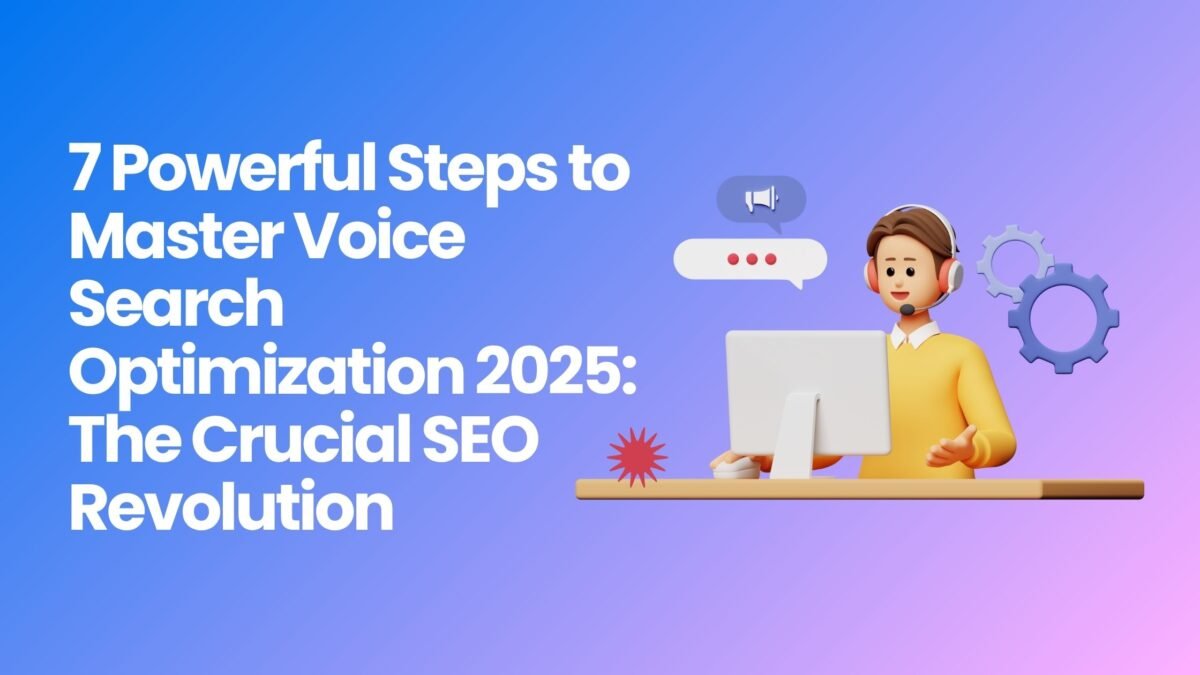
Introduction: Voice Search Optimization 2025—The New Digital Frontier
The digital landscape is undergoing a powerful transformation, one that is literally changing the way people talk to the internet. We are standing at the tipping point of the most significant shift since the mobile-first index: the rise of the voice-first web. No longer a novelty, Voice Search Optimization 2025 is not merely a trend; it is the crucial pillar of modern search engine optimization (SEO) strategy. If your content isn’t optimized for how people speak, you are already losing a massive, growing, and highly-engaged audience.
Consider this powerful number: By 2025, it’s projected that billions of voice-enabled devices will be in use worldwide, with a significant percentage of all searches being conducted via voice. This is a crucial and undeniable revolution, not a minor update. For forward-thinking businesses, mastering Voice Search Optimization 2025 is the only way to ensure your content is heard, literally. This comprehensive guide details the 7 Powerful steps you must take to conquer the conversational search landscape and secure your top-ranking position in this crucial next phase of SEO. We will ensure your Voice Search Optimization 2025 strategy is rock-solid.
1. Target Long-Tail Conversational Keywords: Speak the User’s Language
The fundamental difference between traditional SEO and Voice Search Optimization 2025 lies in the keywords. Typed searches are often short, choppy, and transactional, like “best SEO agency Mumbai.” Voice queries, however, are naturally longer, more descriptive, and conversational, mirroring how people actually speak: “Hey Google, what is the best SEO agency in Mumbai that offers voice search optimization?”
The average voice search query is significantly longer than a typed one. To excel at Voice Search Optimization 2025, you must pivot your keyword strategy to focus on long-tail conversational keywords. This includes phrases that begin with classic interrogative words: Who, What, Where, When, Why, and How.
- Actionable Tip: Use tools like AnswerThePublic or simply analyze the “People Also Ask” section of Google Search Results Pages (SERPs). Incorporate these long, natural language questions directly into your blog headings and content. Your content should feel like a direct, natural-sounding answer to a spoken question, a crucial element of effective Voice Search Optimization 2025. This will ensure that your content is perfectly aligned with the user’s intent and the core principles of Voice Search Optimization 2025.
2. Dominate Position Zero: The Featured Snippet Battleground
In Voice Search Optimization 2025, the featured snippet—often called “Position Zero”—is the ultimate prize. Why? Because when a user asks a voice assistant a question, the assistant almost always pulls its single, direct answer from the content residing in the featured snippet. If you aren’t the featured snippet, your content will likely not be read aloud. This makes achieving Position Zero a crucial priority.
Voice search statistics reveal that a substantial majority of voice answers are sourced from these snippets. Therefore, your content structure needs to be engineered specifically to capture this coveted spot.
- Actionable Tip: Structure your content with a clear, direct question immediately followed by a concise, authoritative answer, ideally 29 words or less. Use bulleted lists, numbered steps, and tables, as these formats are easy for search engines to scan and extract for featured snippets. This concise structuring is a powerful technique for Voice Search Optimization 2025.
3. Local SEO: The Near Me Voice Advantage
A powerful majority of voice searches have local intent. Users are often on the go, using their voice assistants to find immediate information about businesses, such as, “Siri, where is the closest coffee shop open now?” or “Alexa, call a plumber near me.” If your business relies on local customers, local Voice Search Optimization 2025 is absolutely crucial.
This is one of the clearest paths to immediate conversions through voice. An optimized local presence ensures you appear in the “local 3-pack,” which is often the sole result delivered by a voice assistant.
- Actionable Tip: Claim, verify, and meticulously optimize your Google Business Profile (GBP). Ensure your Name, Address, and Phone number (NAP) are consistent across every directory and platform (your website, Facebook, Yelp, etc.). Encourage and reply to customer reviews, as social proof is a powerful local ranking signal. For top-tier Voice Search Optimization 2025, weave location-specific, natural-language keywords into your website content and GBP description.
4. Prioritize Mobile-First & Blazing Fast Page Speed
Voice search is intrinsically linked to mobile usage. Most voice queries are made via smartphones or smart speakers. This means a flawless mobile experience is non-negotiable for successful Voice Search Optimization 2025. A poor mobile experience is a crucial mistake that will negate all your other efforts.
Furthermore, voice users demand instant gratification. They expect an answer immediately, not after watching a page slowly crawl to life. Speed is not just a ranking factor; it’s a conversion factor.
- Actionable Tip: Implement a fully responsive, mobile-first design. Use tools like Google PageSpeed Insights to analyze and aggressively improve your load times. Aim for a load time under two seconds. Compressing images, leveraging browser caching, and minimizing CSS/JavaScript are powerful technical steps for Voice Search Optimization 2025.
5. Implement Schema Markup (Structured Data): The Translation Key
Schema markup, or structured data, is the language search engines use to understand the context of your content. In the world of Voice Search Optimization 2025, it acts as a crucial translator, helping the search engine understand exactly which part of your page provides the answer to a spoken query. Without it, you leave the interpretation of your content up to chance.
Specific schema types are particularly powerful for voice search visibility.
- Actionable Tip: Focus on implementing FAQ Schema to mark up your question-and-answer pairs, making it easier for voice assistants to extract those concise answers. Also, use HowTo Schema for guides and LocalBusiness Schema for local entities. This technical optimization is crucial for high-performance Voice Search Optimization 2025.
6. Write at a Conversational Reading Level: Clarity is King
Voice assistants are programmed to deliver information in a clear, easy-to-digest format. Studies have consistently shown that content featured in voice search results is often written at a middle-school (or Ninth Grade) reading level. Overly technical jargon, dense paragraphs, and complex sentence structures are a crucial barrier to effective Voice Search Optimization 2025.
Your goal should be to create content that sounds like a human speaking to another human—simple, direct, and engaging.
- Actionable Tip: Use Hemingway Editor or similar tools to check your content’s readability. Break up long paragraphs. Use active voice and an informal, conversational tone. While maintaining depth, ensure that your core answers are presented with immediate clarity. This is a powerful stylistic adjustment for Voice Search Optimization 2025.
7. Leverage Voice Intent Mapping: Going Beyond the Keyword
The final and arguably most powerful step in Voice Search Optimization 2025 is understanding user intent. Voice queries are exceptionally clear in their intent—a user is either looking to Know (informational), Do (transactional), or Go (navigational/local). A simple keyword match is no longer enough; you must provide content that completely satisfies the underlying goal of the voice query.
- Actionable Tip: Categorize your voice-friendly keywords by intent. For “Know” questions (e.g., “What is Voice Search Optimization 2025?”), create comprehensive, authoritative blog posts. For “Do” intent (e.g., “How do I optimize for voice search?”), create step-by-step guides. By mapping intent, you provide the most relevant, single-best answer, which is crucial for any search engine’s ranking algorithm in this era of Voice Search Optimization 2025.
Conclusion: The Future of Voice Search is Now
The shift toward voice search is powerful, crucial, and happening rapidly. The businesses that embrace Voice Search Optimization 2025 now are the ones who will reap the powerful rewards of high visibility, brand authority, and increased conversion rates. Neglecting this crucial SEO revolution is a mistake that could cost you a significant portion of your future organic traffic.
Remember the 7 Powerful steps: conversational keywords, featured snippet dominance, local mastery, blazing speed, schema markup, conversational tone, and intent mapping. Implement these tactics, and you will not only be prepared for the future of search but will be actively dominating it. Voice Search Optimization 2025 is your crucial strategy for success. The time to optimize your content for voice is now!




